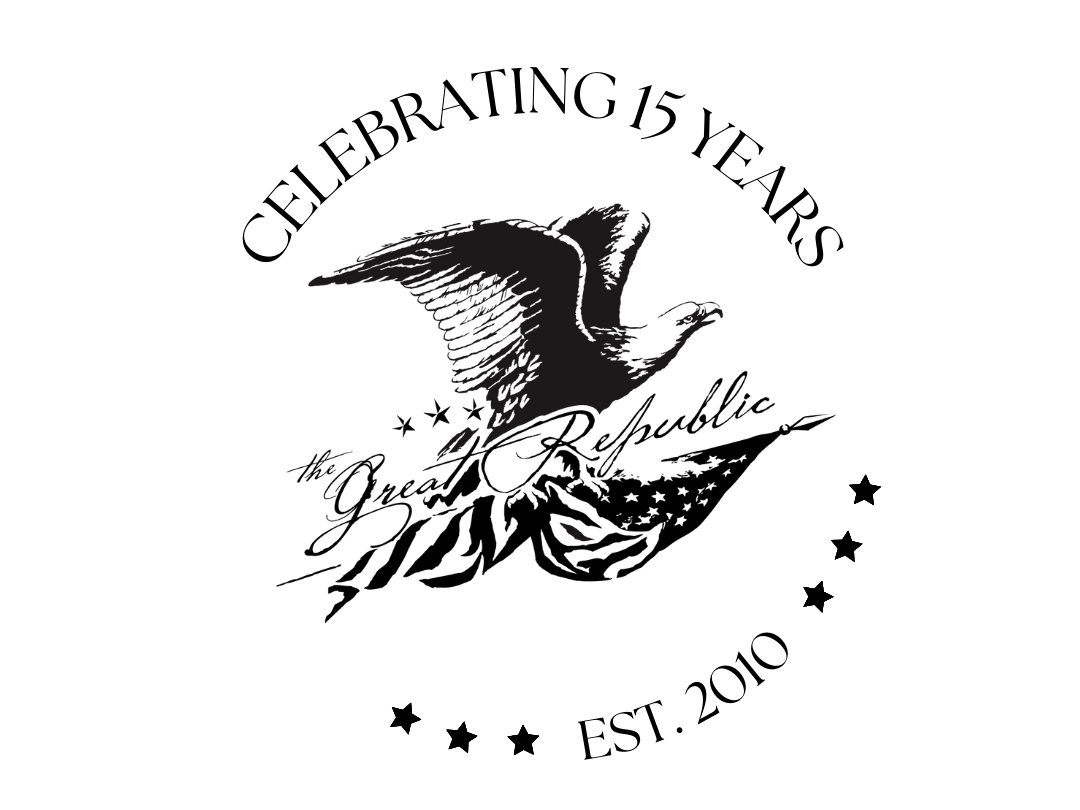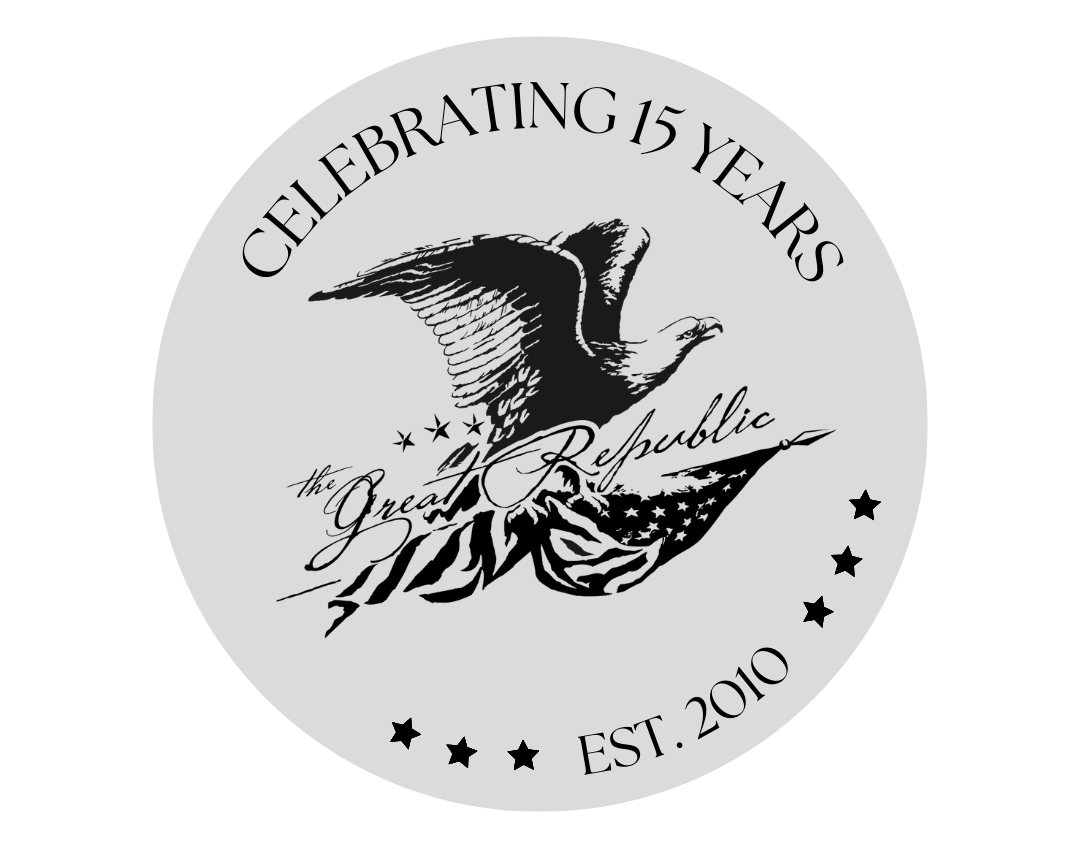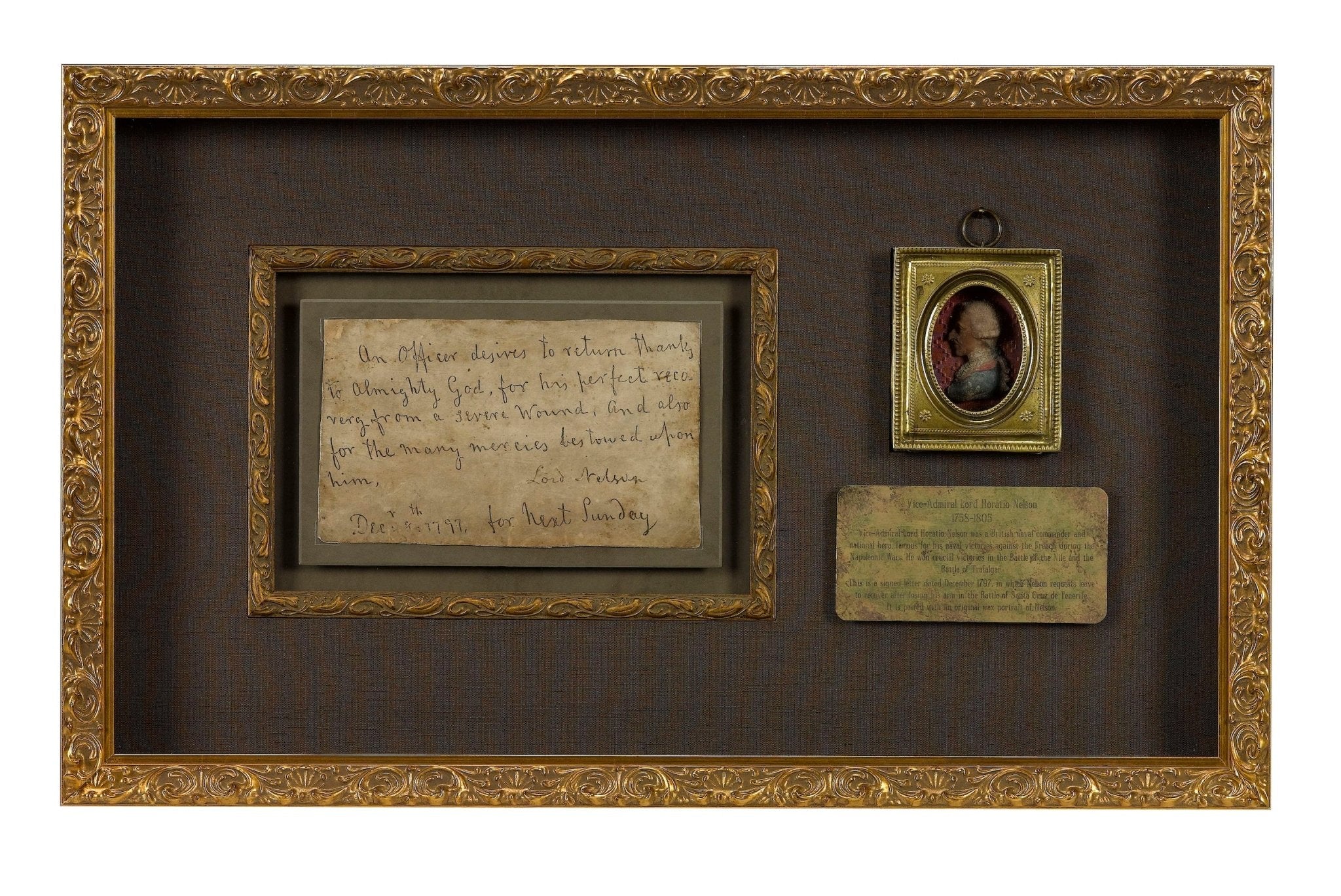
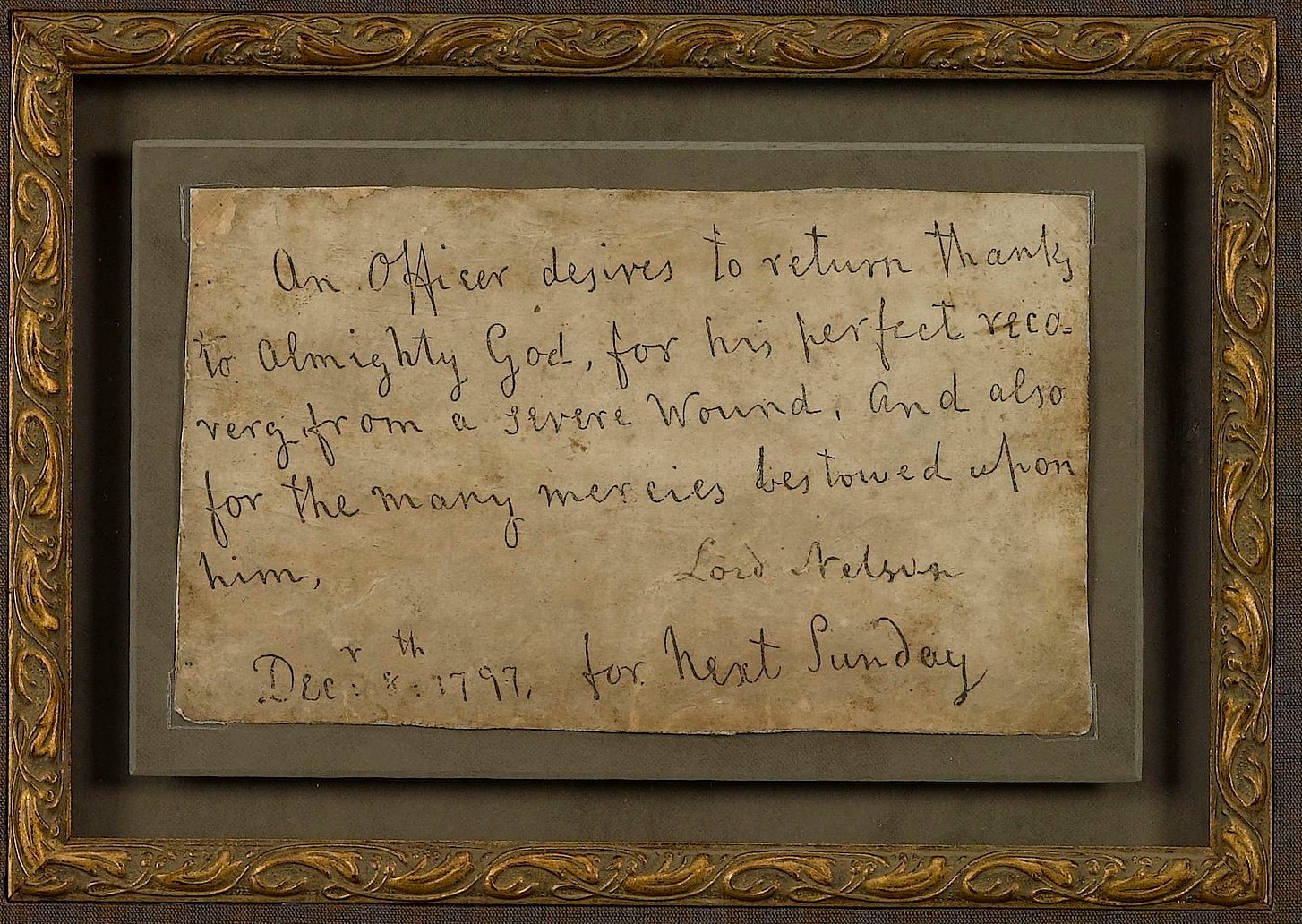
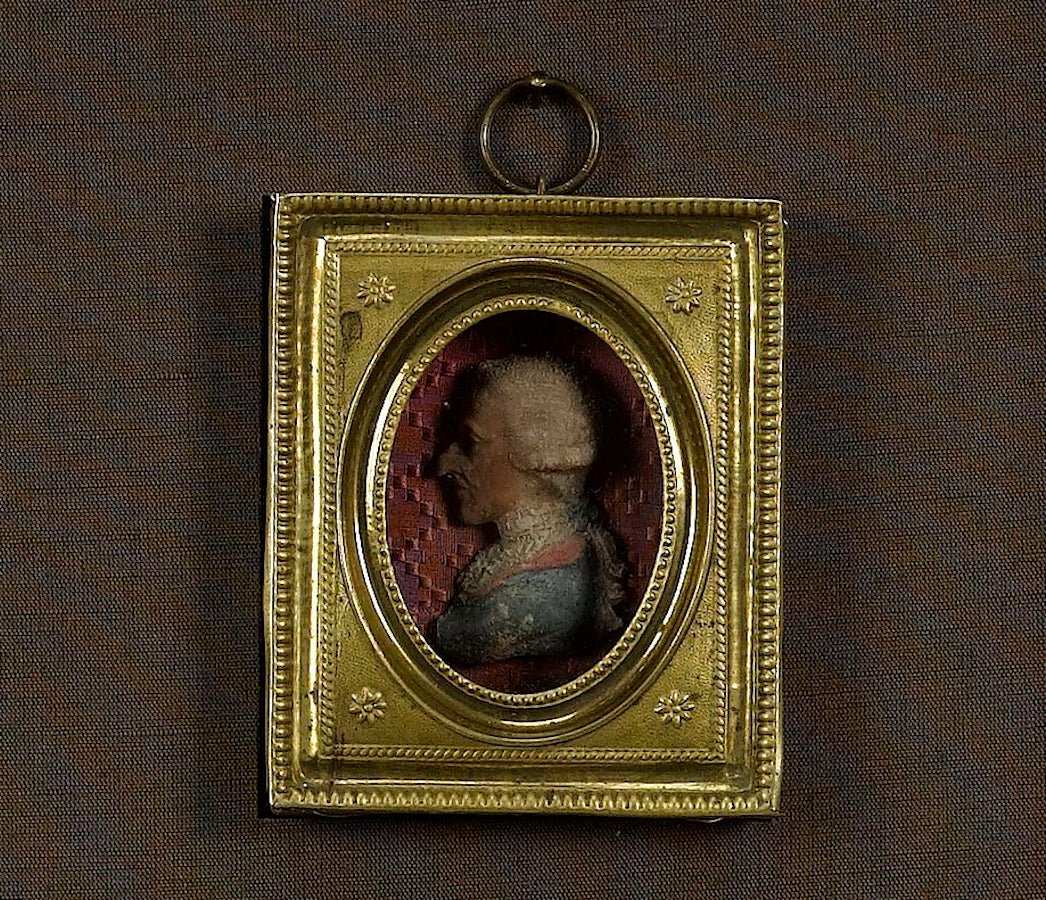
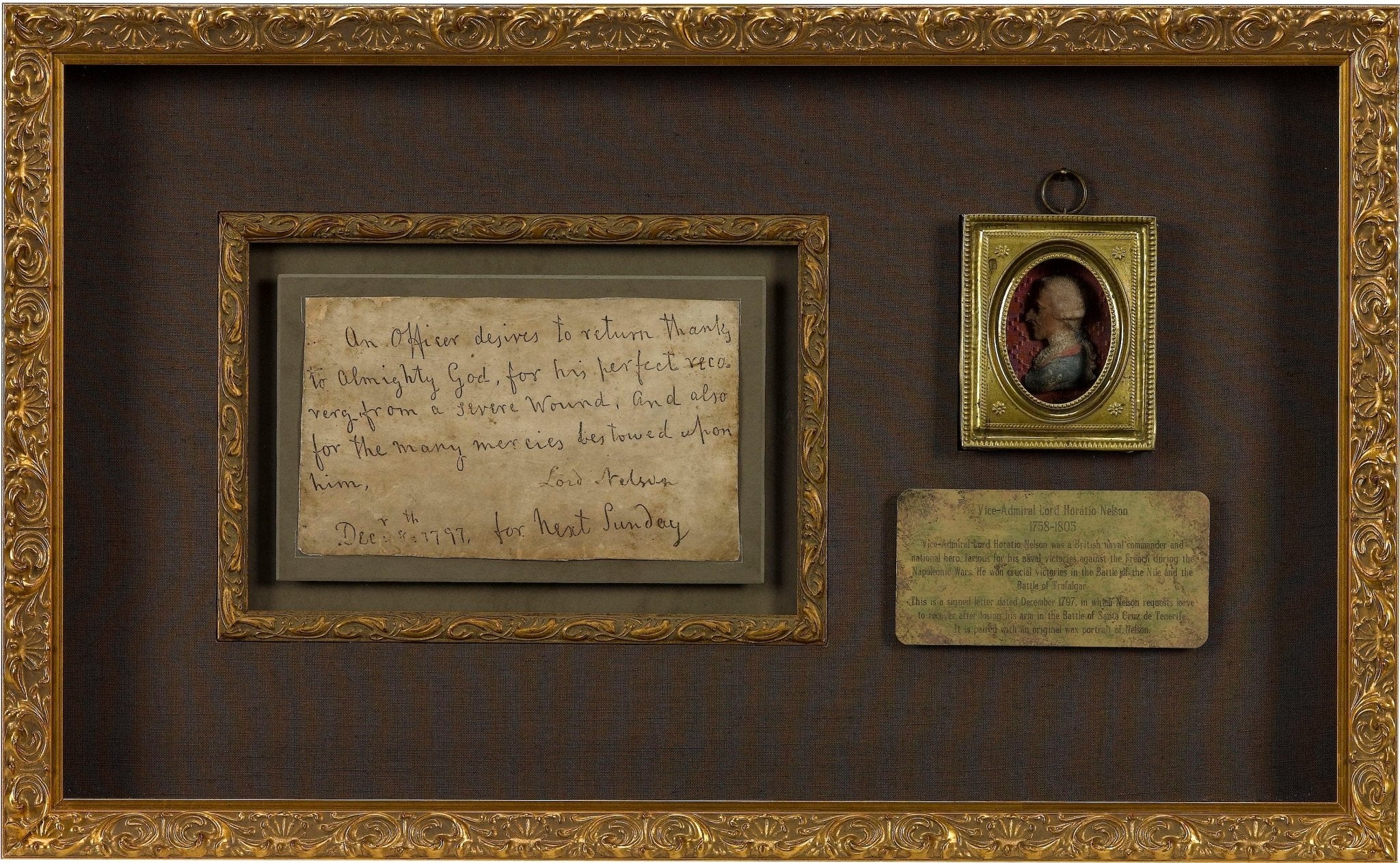
Horatio Nelson Signed Letter and Portrait, 1797
Presented is a signed handwritten note by the famous British naval commander, Vice-Admiral Lord Horatio Nelson. Nelson was a British naval commander and national hero, famous for his naval victories against the French during the Napoleonic Wars. He won crucial victories in the Battle of the Nile and the Battle of Trafalgar. The letter is dated December 1797, in which Nelson requests leave to recover after losing his arm in the Battle of Santa Cruz de Tenerife. This rare Nelson letter was one of several prominent American and British statesman autographs collected together and bound in a 1809 volume of the Baltimore Evening Post. The letter is paired with an original wax portrait of Nelson, dating to the early 19th century.
The letter, inscribed in black ink, reads, in full: “An Officer desires to return, thanks to Almighty God, for his perfect recovery from a severe wound, And also for the many mercies bestowed upon him, Lord Nelson, Dec.r 8th, 1797, for Next Sunday”
In 1797, then Rear-Admiral Nelson was stationed off Cadiz and was ordered to take possession of the town and harbour of Santa Cruz in Tenerife, where Spanish treasure ships were reported to be lying. He immediately set sail on HMS Theseus with two other ships, three frigates, and a cutter, and was joined by a fourth frigate and a bomb vessel en route. The expedition counted 400 guns and nearly 4,000 men. After several failed attempts to reach the harbour, Nelson decided upon a direct assault on Santa Cruz by night, aiming for the central castle of San Cristobal where the Spanish general staff were based. Nelson commanded the attack, leading one of six divisions of boats, the other five being commanded by Captains Troubridge, Miller, Hood, Waller and Thompson. With muffled oars the British seamen began the two-mile row to the beach. However, many of the initial boat-landings were swept off course and the element of surprise was lost.
During his attempt to land, Nelson was hit just above the right elbow by a musket just as he was about to disembark. The hit shattered his bone and joint, and Nelson was forced to have his arm amputated aboard the Theseus that night. Nelson was cited as saying, as he pointed to his right arm "Doctor, I want to get rid of this useless piece of flesh here". Within half an hour, Nelson had returned to issuing orders to his captains. The attack ground to a halt, the British force landed at the harbour negotiating a truce with the Spanish Governor under which they returned to their ships.
Nelson returned to England, aboard HMS Seahorse, arriving at Spithead in September. His wound earned him sympathy and he was met with a hero's welcome. The British public refused to attribute the defeat at Tenerife to him, preferring instead to blame poor planning on the part of St Vincent, the Secretary at War, William Windham, and Prime Minister William Pitt. He spent the final months of 1797 recuperating in London, during which time, he was awarded the Honorary Freedom of the City of London. He returned to service in March of 1798, in command of the HMS Vanguard.
The letter is accompanied by a small wax portrait of Lord Nelson, executed in bas-relief. The colorized wax portrait shows Nelson in head and shoulders profile, and is presented in its original gold punched shadowbox frame. It dates to the early 19th century.
During the 16th century, a new use of wax in portraiture started in Italy, and soon spread to other countries in Europe. Highly finished polychromatic portraits were modelled on a miniature scale, in a format very closely related medallion and cameo arts. Italian medallists developed techniques of producing colored wax portraits by mixing the wax with pigments, so they could render color, texture and detail of flesh, clothing, and hair in a highly realistic manner. Because the art was initially reserved to the aristocracy, jewels and precious metals were often incorporated into these miniature masterpieces. They were often created and given as gifts in noble and bourgeois circles. Miniature wax portraits were exceedingly popular from the mid 18th century until the introduction and popularization of photography in the 1840’s.
CONDITION:
Very good condition overall. Letter and signature in black ink, on cut toned paper. Ink has faded from black to dark brown, but is still legible and strong. Letter has been archivally lifted from a larger page of pasted cut signatures.
A small wax portrait of Lord Nelson, in the original gold punched tin shadowbox frame. Wax has signs of age, with some surface dust stuck to the wax. The colors of the wax portrait are still vibrant. Gold frame measures 3 ¾” H x 3” W.
The signed letter and wax portrait are framed together in a custom, archival frame, with acid-free black linen mat, gold spandrels, a descriptive gold-leaf plaque, UV Conservation Clear glass, and a hand-built black and gold frame.
Framed Dimensions: 13 5/8"H x 22 1/8"W x 2"D
Accompanied by our company's letter of authenticity.
Pickup available at Colorado
Usually ready in 4 hours

Horatio Nelson Signed Letter and Portrait, 1797
Colorado
1 Lake Avenue
Colorado Springs CO 80906
United States
Choose options




Frequently Asked Questions
FAQs
Yes, all of our Antiques are certified authentic. Every antique comes with a signed Letter of Authenticity that details the item’s history, its current condition including any conservation, binding, or framing work, and the item’s provenance. The Letters of Authenticity are priced valuations by our authentication specialists, who assure that items are original and unconditionally guaranteed as genuine for life.
We pack and ship your items from our gallery in Colorado Springs. You may also choose to come pick up your order. Antique items are carefully packed and insured during shipping. The shipping price will be calculated at checkout.
We acquire from a variety of trusted sources all over the world, but mostly through auctions and private collections within the United States. All provenance information will be listed on the Letter of
Authenticity accompanying your purchase.
